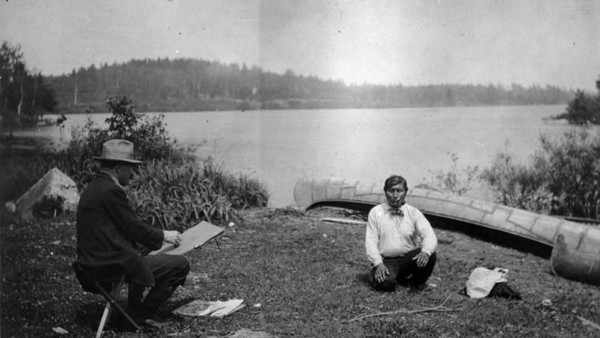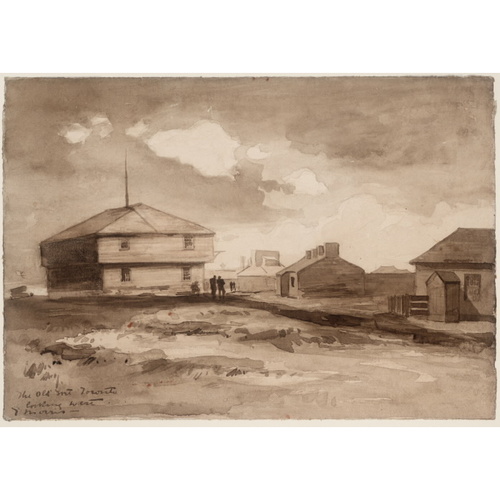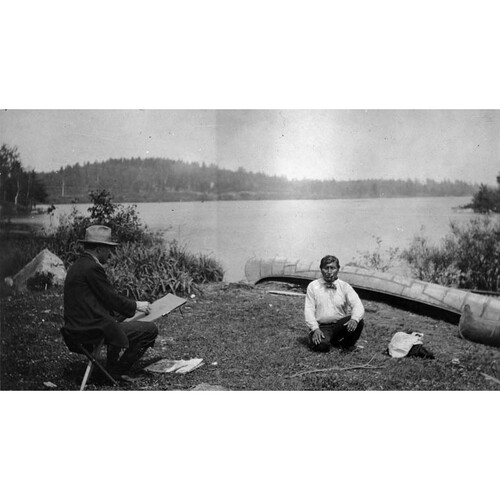MORRIS, EDMUND MONTAGUE, artist and author; b. 18 Dec. 1871 in Perth, Ont., youngest child of Alexander Morris* and Margaret Cline; d. unmarried about 21 Aug. 1913 near Portneuf, Que., and was buried in the Mount Pleasant Cemetery, Toronto.
Edmund Morris was born into a prominent Ontario family. As a child he lived in Winnipeg, where his father was first a judge and then lieutenant governor. The family returned to Ontario in 1878, and Edmund later attended Toronto Collegiate Institute. After working briefly for the architectural firm Darling and Curry, he switched to art and in January 1890 began studies with Toronto artist William Cruikshank. The following year he went to the Art Students’ League in New York. He studied in Paris between 1893 and 1896, first at the Académie Julian and later at the École des Beaux-Arts. Summers were spent painting in Scotland, France, and Holland.
Morris returned to Toronto in 1896. The following summer he discovered the charm of Quebec when he joined Montreal artists Edmond Dyonnet and Maurice Galbraith Cullen* on the Beaupré shore. At Île d’Orléans he met Horatio Walker*, who had a studio there. The region became a summer rendezvous for Morris and his artist friends, sometimes including Cruikshank and William Brymner*.
Financially independent through family inheritances, Morris began about 1900 to devote his energies to the cause of Canadian art. He arranged for works by himself and others to be sent to the International Exhibition held at Glasgow in 1901. He himself won a bronze medal at the Pan-American Exposition in Buffalo, N.Y., that fall for his Girls in a poppy field. He was elected to the Ontario Society of Artists in 1905 but resigned two years later to help form the Canadian Art Club, established to give Canadian artists greater opportunity to exhibit their work at home. From 1909 he also served on the council of the nascent Art Museum of Toronto (later the Art Gallery of Toronto).
At a one-man show in Ottawa in 1905, portraits of native chiefs Poundmaker [Pītikwahanapiwīyin*], Big Bear [Mistahimaskwa*], and Crowfoot [Isapo-muxika*], which Morris had painted from photographs, were purchased by Indian Affairs official Duncan Campbell Scott* on order from Prime Minister Sir Wilfrid Laurier. The following year Morris was commissioned by the Ontario government to accompany the party, headed by Scott, that travelled through northern Ontario to negotiate Treaty No.9. He was to make portraits of as many native leaders as he could. For these portraits he used pastels, which he found to be an excellent medium for depicting a subject who might pose awhile and then suddenly walk away. It was his first direct contact with native peoples, and he was appalled at the conditions under which they lived. He subsequently went with a party of natives to Nipigon country, where he sketched the wilderness landscape.
The portraits were exhibited in Toronto in March 1907. They attracted great public interest, and Ontario premier James Pliny Whitney commissioned Morris to search out chiefs in the northwest who had signed earlier treaties. In June he went to Manitoba and enlisted the help of Acheson Gosford Irvine, former commissioner of the North-West Mounted Police. Irvine was able to direct him to places where native leaders might be found. With pastels and camera he travelled from camp to camp and learned that his father and Irvine were both remembered with respect. His first portrait was of Crowfoot’s favourite wife, Sisoyaki (Cutting Woman), now an old woman. He visited Blackfoot, Sarcee, Blood, and Peigan reserves in 1907, and he made another trip west the following year, during which he added portraits of Cree, Saulteaux, Assiniboin, Stoney, and Sioux leaders.
In 1909 the Canadian Art Club held an exhibition in Toronto at which 55 portraits were displayed, together with native artefacts collected by Morris and his father, including head-dresses and articles of clothing. In an accompanying catalogue he described the tribal background of his subjects. One reviewer commented, “When first seen these portraits are criticized for the brilliance of color but when compared with the original garments, some of which Mr. Morris has hung between the groups of portraits, one sees that the artist has really been working in half tones and subdued lights.” This unusual exhibition created quite a stir in the city, and Premier Whitney commissioned additional portraits for the Ontario government collection. That year the Saskatchewan government ordered 15 portraits for the legislative building under construction in Regina, and in 1910 Morris completed 5 portraits for the province of Alberta.
In all, Morris made four trips to the northwest. As he travelled among the native peoples, his understanding of their history and culture grew. He carefully recorded in his diaries the tales they told him, and he persuaded some chiefs to record their personal achievements on buffalo skins he provided. In a letter on “The Indian problem” written to the Manitoba Morning Free Press in 1910, he wondered what “we [are] reducing them to by thrusting upon them our so-called civilization.”
He continued to exhibit annually with the Royal Canadian Academy of Arts, of which he had been an associate since 1898, and in private galleries and to serve as secretary of the Canadian Art Club. About this time he wrote Art in Canada: the early painters ([1911?]), one of the first studies of the history of Canadian art. He was also involved in planning a monument to commemorate the signing of Treaty No.4 at Fort Qu’Appelle (Sask.). In August 1913, overworked and possibly depressed, he went to Île d’Orléans to paint. On the 25th his body was found in the St Lawrence River near Portneuf. He was 41.
Edmund Morris is known principally for his striking portraits of native peoples, a record of the last generation to remember life before European settlement. A contemporary reviewer of his broadly handled landscapes praised the “varied and elusive manifestations of light . . . constantly shifting play of colour; the brilliant skies.” More recently a critic, Geoffrey Simmins, has written of one work that it is “among the most advanced landscape paintings executed during these years by any Canadian artist.” The promise shown in his landscapes was cut short by his early death.
In addition to his book, Art in Canada: the early painters ([Toronto, 1911?]), Edmund Montague Morris’s publications include several articles: “An ancient Indian fort” and “L’t-Col. Irvine and the North-West Mounted Police” in Canadian Magazine, 36 (November 1910-April 1911): 256–59 and 37 (May-October 1911): 493–503, respectively; “Art in Canada: the early painters,” Saturday Night, 21 Jan. 1911: 25, 29; “Early Canadian painters,” Arts and Letters Club, Lamps (Toronto), 1 (1911–12), no.2: 8; and “Old lords of the soil; description of Indians living near James Bay,” News (Toronto), 9 May 1907. His letter on “The Indian problem” appears in the Manitoba Free Press, 22 Oct. 1910. Morris also prepared two catalogues for his 1909 Canadian Art Club exhibition: Canadian Art Club exhibition of Indian portraits; with notes on the tribes and Catalogue of loan collections of objects of Indian art and curios on view at the exhibition of Indian portraits by Edmund Morris, both published at Toronto in 1909.
Morris’s diaries for 1886–1904 and for his 1906 journey to James Bay are in his papers in QUA: his western diaries are preserved in the Ethnology Dept. of the Royal Ontario Museum (Toronto), and have been transcribed by Mary Fitz-Gibbon and published as The diaries of Edmund Montague Morris; western journeys, 1907–1910 (Toronto, 1985).
The Ontario government collection of Indian portraits is now in the Ethnology Dept. of the Royal Ontario Museum. Works by Morris are also held by the National Gallery of Canada (Ottawa), the Art Gallery of Ontario (Toronto), the Art Gallery of Hamilton (Hamilton, Ont.), the Glenbow Museum (Calgary), the Provincial Museum of Alberta (Edmonton), and the Sask., Legislative Building, Art Galleries (Regina). In addition, a collection of over 700 photographs of native people and the landscape taken by Morris on his western journeys is in the PAM.
Morris’s painting is compared with that of his contemporaries and his place in the history of Canadian art is assessed in Edmund Morris, “Kyaiyii,”1871–1913, comp. Geoffrey Simmins and Michael Parke-Taylor, prepared for a major retrospective exhibition held at the Norman Mackenzie Art Gallery (Regina, 1984). This study includes a list of exhibitions of Morris’s works (app.A), but no listing of his paintings by present-day holder is available.
AO, F 51; F 1140. Art Gallery of Ontario Library, Canadian Art Club papers; Edmund Morris, artist’s file; Edmund Morris letter-books. NA, MG 30, D6. North York Public Library (North York, Ont.), Canadiana Coll., Newton Mac-Tavish coll. PAM, MG 12, B1 ;.B2; MG 14, C30. Univ. of Toronto Library, Thomas Fisher Rare Book Library, ms coll. 1 (B. E. Walker papers); ms coll. 13 (D. C. Scott papers); ms coll. 119 (James Mavor papers). Daily Mail and Empire, 26 Aug. 1913. Globe, 26 Aug. 1913.
American Art News (New York), 24 April 1909. W. M. Boultbee, “Edmund Morris, painter,” Canadian Magazine, 31 (May–October 1908): 121–27. Catalogue of the Ontario Society of Artists: fifty-sixth annual exhibition and the Edmund Morris memorial exhibition (Art Gallery of Toronto, 1928; copy in the Art Gallery of Ontario Library). A dictionary of Canadian artists, comp. C. S. MacDonald (7v. to date, Ottawa, 1967– ). J. S. McGill, Edmund Morris: frontier artist (Toronto, 1984); “Edmund Morris among the Saskatchewan Indians and the Fort Qu’Appelle monument,” Sask. Hist., 35 (1982): 101–7; “The Indian portraits of Edmund Morris,” Beaver, outfit 310 (1979–80), no.1: 34–41. N. [McF.] MacTavish, Ars longa (Toronto, 1938). D. [R.] Reid, A concise history of Canadian painting (Toronto, 1973). D. C. Scott, “Lines in memory of Edmund Morris,” in The poems of Duncan Campbell Scott (Toronto, 1926), 141–50. Studio (London), 22 (February-May 1901): 209–10.
Cite This Article
Jean S. McGill, “MORRIS, EDMUND MONTAGUE,” in Dictionary of Canadian Biography, vol. 14, University of Toronto/Université Laval, 2003–, accessed January 20, 2025, https://www.biographi.ca/en/bio/morris_edmund_montague_14E.html.
The citation above shows the format for footnotes and endnotes according to the Chicago manual of style (16th edition). Information to be used in other citation formats:
| Permalink: | https://www.biographi.ca/en/bio/morris_edmund_montague_14E.html |
| Author of Article: | Jean S. McGill |
| Title of Article: | MORRIS, EDMUND MONTAGUE |
| Publication Name: | Dictionary of Canadian Biography, vol. 14 |
| Publisher: | University of Toronto/Université Laval |
| Year of revision: | 1998 |
| Access Date: | January 20, 2025 |





